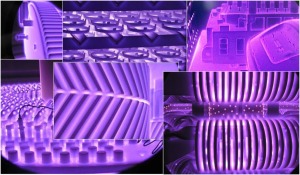When and Why Ion Nitriding/Nitrocarburizing Makes Good Sense
When and Why Ion Nitriding/Nitrocarburizing Makes Good Sense
Advanced Heat Treat staff Dr. Edward Roliński and Gary Sharp authored this article from Industrial Heating magazine, August 11, 2005:
Ion, or plasma, nitriding has been studied and used industrially for more than 40 years [1-8], but the technology has not been used to its full potential. Ion nitriding/nitrocarburizing is a low temperature (800-1100˚F, or 430-595˚C) process, which results in little or no distortion of the treated parts even if significant residual compressive stress is induced to the surface layer of the treated products. The ion nitriding process also has been referred to by other surface treating characteristics including plasma, vacuum, diffusion, low nitriding potential, passive surfaces activating, easy-to-control structure and pollution-free processes. These process characteristics with the exception of the low nitriding potential concept are discussed in the literature.”
Click here to read the entire article:
http://www.industrialheating.com/Articles/Feature_Article/f022e50797cb7010VgnVCM100000f932a8c0
Learn more about the authors here www.ahtweb.com
Gas Nitriding/Gas Nitrocarburizing
Gas Nitriding or Gas Nitrocarburizing is a case-hardening process whereby nitrogen is introduced into the surface of a solid ferrous alloy by holding the metal at a suitable temperature in contact with a nitrogenous gas, usually ammonia.
Benefits include:
- Extends part/tool life
- Adds performance, fatigue strength and endurance
- Enhances surface lubricity
- Reduces erosion
- Increases material flow in molds and dies
- Improves corrosion resistance
- No post-process machining
- Improves wear resistance
- Zero to minimal growth/distortion
- Precise and versatile
- Phase controllable compound zone
Recommended for:
- Stainless steels
- Tool steels
- Powdered metals
- Medium carbon steels
Learn more at: www.ahtweb.com
Nitriding and Nitrocarburizing
Nitriding/Nitrocarburizing Types:
- Ion Nitriding (Plasma Nitriding / Nitrocarburizing)
- Gas Nitriding (Gaseous Nitrocarburizing)
- Salt-Bath Nitriding (Liquid)
Photo of Ion Nitriding:
Induction Hardening
The Burton facility in Waterloo, IA is the oldest Advanced Heat Treat Corp. location and specializes in UltraGlow Induction Hardening, Carburizing, Carbonitriding, Stress Relieve, Quench & Temper/Through Hardening, Annealing, Normalizing, Cold Treatment, Oxidation Treatment, Duplex Hardening, Assembly, Cleaning Applications, and MUCH MORE! Here’s a photo of a part being induction heated:
Induction hardening is a method of heating electrically conductive materials to a temperature within or above its transformation range by means of a varying magnetic field. This process generates a voltage which has the ability to create and electric current that dispels energy and produces heat by flowing against the resistance of an imperfect conductor. After the metal is heated, it is immediately quenched. Induction hardening results in a hardened case while the core of the part remains unaffected.
Case Depth Terms
When applying a heat treatment, such as ion nitriding, to a part, it is important to know the following case depth terms:
Effective Case Depth (ECD):
The distance from the surface of a hardened case where a specified level of hardness is maintained (typically 50 HRC eqv.).
Total Case Depth (TCD):
The distance from the surface of a hardened case to a point where differences in physical properties of the case and core are no longer distinguished (visual or hardness method).
For example:
 For more information, visit www.ahtweb.com.
For more information, visit www.ahtweb.com.
What is Heat Treat?
Heat treat is a process in which a material is heated and/or cooled in a particular manner to alter its mechanical properties such as hardness, tensile strength, yield strength and fatigue strength. Learn more at www.ahtweb.com.




